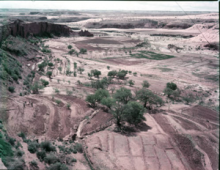Article
Fruitland began as a Mormon community and Navajo Trading post located in San Juan County, New Mexico. This community was named in order to advertise its agricultural resources. The Navajo term for Fruitland is Bááh Díílid, which means “burning bread,” and Fruitland received this name after a group of Navajo witnessed Mormons burning a batch of bread.
Although the general area was eventually added to the Navajo Nation Reservation, Fruitland, the community, is on the north bank of the San Juan River and not on the actual reservation itsel, which runs on the south side of the river. This area was also the site for the precursor of the Navajo Indian Irrigation Project. The early stages of this long-term project, which began in 1973, allotted small portions of land to Navajos to irrigate and farm by using water harnessed from the San Juan River by the Navajo Dam and Navajo Lake, which are about 50 miles east of Fruitland.
"Aerial view of fields in Fruitland, on the Navajo Reservation, 1953," photograph by John Collier, jr. (2006_20_696). Farmington Museum.
Manuscripts
References
Bureau of Reclamation, U.S. Department of the Interior
2014 Navajo Indian Reservation Project. http://www.usbr.gov/projects/Project.jsp proj_Name=Navajo+Indian+Irrigation+Project, accessed October 17, 2014.
Linford, Laurance D.
2001 Tony Hillerman's Navajoland: Hideouts, Haunts, and Havens in the Joe Leaphorn
and Jim Chee Mysteries. Salt Lake City: University of Utah Press.

